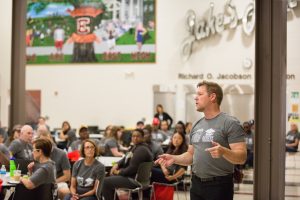Grad Walk Focus Shifts as Dropout Rate Falls

Superintendent Dr. Thomas Ahart addresses Grad Walk volunteers at East High School.
The 8th annual Graduation Walk Saturday was faced with a pleasant dilemma. With graduation rates rising and dropout rates dropping the pool of potential contacts for district and community volunteers determined to ensure that every child who starts school finishes school was shrinking.
In 2014 the graduators knocked on over 1,200 doors. Last year that number was in the 700 range. But the focus had been on reengagement of high school students. For 2016 a bigger net was thrown that included middle school students with attendance issues.
“The reason we chose to shift our focus was due to the fact that we have fewer students who have dropped out,” said Allyson Vukovich, Community Partnership Coordinator for DMPS. “Chronic absenteeism (in elementary and middle school) is one of the leading indicators of a student who will end up dropping out of high school.”
Consequently, 1,555 students from all of the DMPS middle and high schools were identified for contact Saturday. Each of them were chronic absentees last year (defined as an attendance rate less than 90%), leading to credit shortfalls and poor grades.
Walkers, 476 of them altogether, knocked on doors all over town Saturday morning, 1,487 of them according to the final, official figures. They extended personal invitations and expressed concern above and beyond the call of the wide range of their respective M-F duties. Their ranks included district employees at levels all the way up to Superintendent Tom Ahart. Community sponsors United Way and Wells Fargo were also well-represented on the rounds, as usual. Besides their concern they bore gifts like t-shirts and backpacks and recorded reenrollment appointments on their clipboards, capitalizing on the momentum that ripples through town at the start of a new school year.
The fact is that there are more obstacles than ever to regular attendance at school in diverse, urban districts like DMPS. And the district’s response to that new reality is to provide more ways than ever to overcome them. The Grad Walk is an opportunity to explain options like the Academic Support Labs at all of the high schools to households where teenagers may have to work during normal school hours to help support their families. Often it’s not about convincing troublemakers to clean up their acts and toe the line. It’s about sharing good news that there are ways to take care of their families and look out for their own futures at the same time.
At 590 homes no one answered. At another 138 the address turned out not to be current for the targeted student(s). But at the end of the day 47 appointments had been arranged to reengage straying students and 576 barriers to attendance had been identified. For purposes of formulating next steps everything is tabulated and entered on a black and white spread sheet comprised of straight lines and distinct compartments. But this event is all about person-to-person outreach, flexibility and the understanding that not everyone fits into boxes on a spread sheet. Maybe doctors don’t make house calls anymore but schools do.
Well, the ones in this district do – lots of them.




